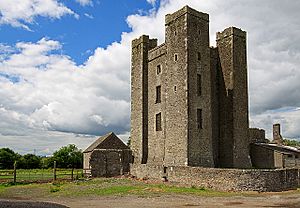Dunsoghly Castle facts for kids
Quick facts for kids Dunsoghly Castle |
|
|---|---|
| Native name Irish: Caisleán Dún Sochlaigh |
|
 |
|
| Type | castle |
| Location | Dunsoghly, St Margaret's, Ireland |
| Built | c. 1450 |
| Official name: Dunsoghly Castle | |
| Reference no. | 230 |
| Lua error in Module:Location_map at line 420: attempt to index field 'wikibase' (a nil value). | |
Dunsoghly Castle is an old castle and a very important historical site in Ireland. It is located in a place called St. Margaret's, in Fingal, County Dublin. It is now protected as a National Monument.
History of Dunsoghly Castle
The castle was built around the year 1450. It was built by a man named Sir Thomas Plunket. He was a very important judge in Ireland at that time.
The castle was lived in for a very long time. Members of the same family lived there continuously until the 1870s. That's over 400 years! Even though it was a bit small and not super comfy by later standards, people kept living in it.
What Does the Castle Look Like?
Dunsoghly Castle is a tall tower with four stories. It has cool, narrow towers called turrets at each corner. These turrets get smaller as they go up and rise above the main wall at the top.
The roof of the castle is very special. It has a unique design made with strong oak beams. This roof design has been so helpful that it was used as a guide for fixing the roofs of other famous castles, like Bunratty Castle and Rothe House.
The Castle Chapel
There is also a small chapel at the castle. It is located on the south side. Above the door of the chapel, you can see the year "1573" carved into the stone. There are also carvings of symbols related to the Passion of Christ. You can also see the initials of Sir John Plunket and his wife, Jenet Sarsfield. Sir John was the grandson of Sir Thomas, who first built the castle. Like his grandfather, Sir John was also a very important judge.
Old Defenses
On the west and south sides of the castle, you can still see parts of old defensive structures. These were mounds or walls made of earth. They were built during fighting in the 1670s to help protect the castle.

